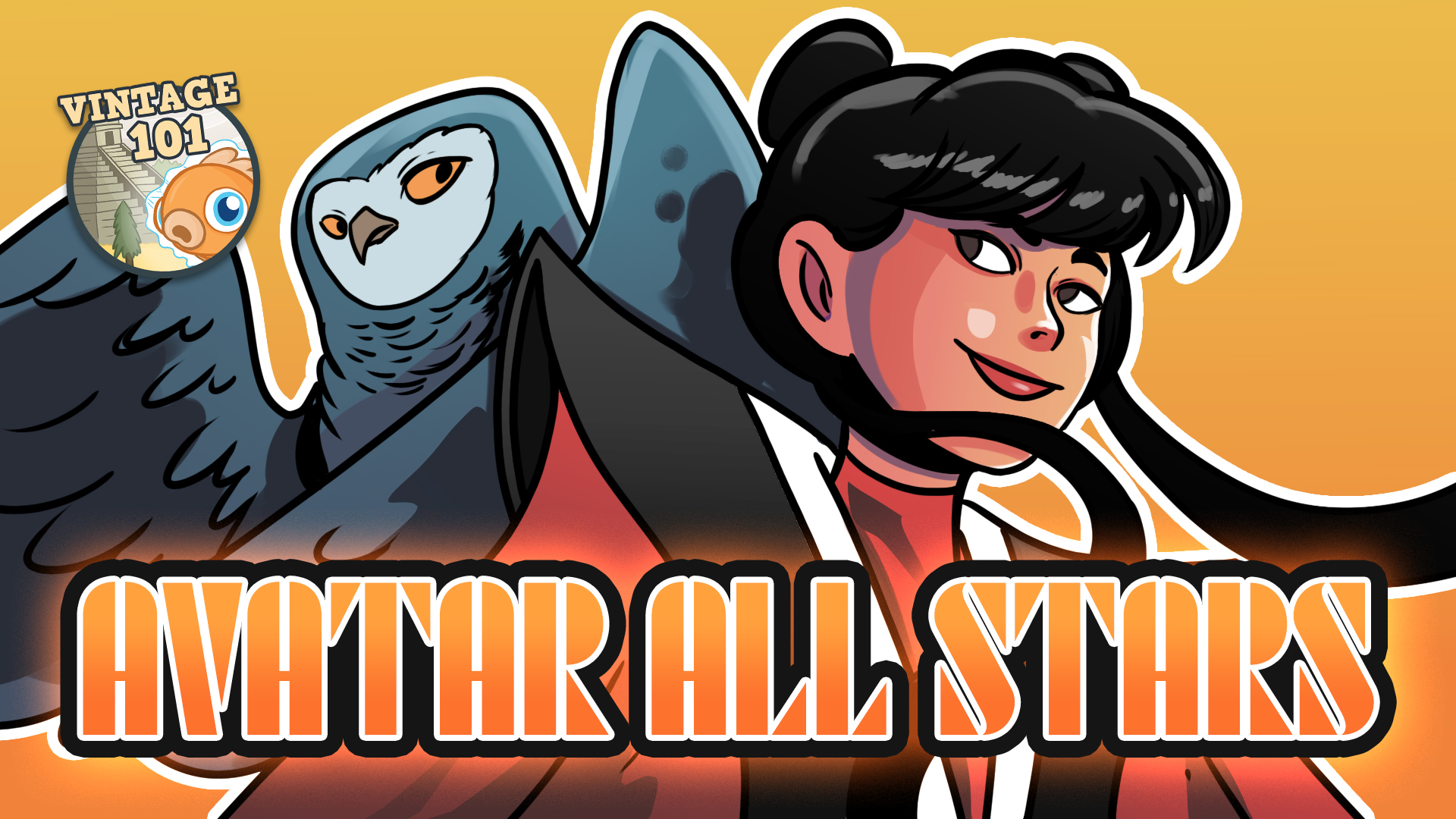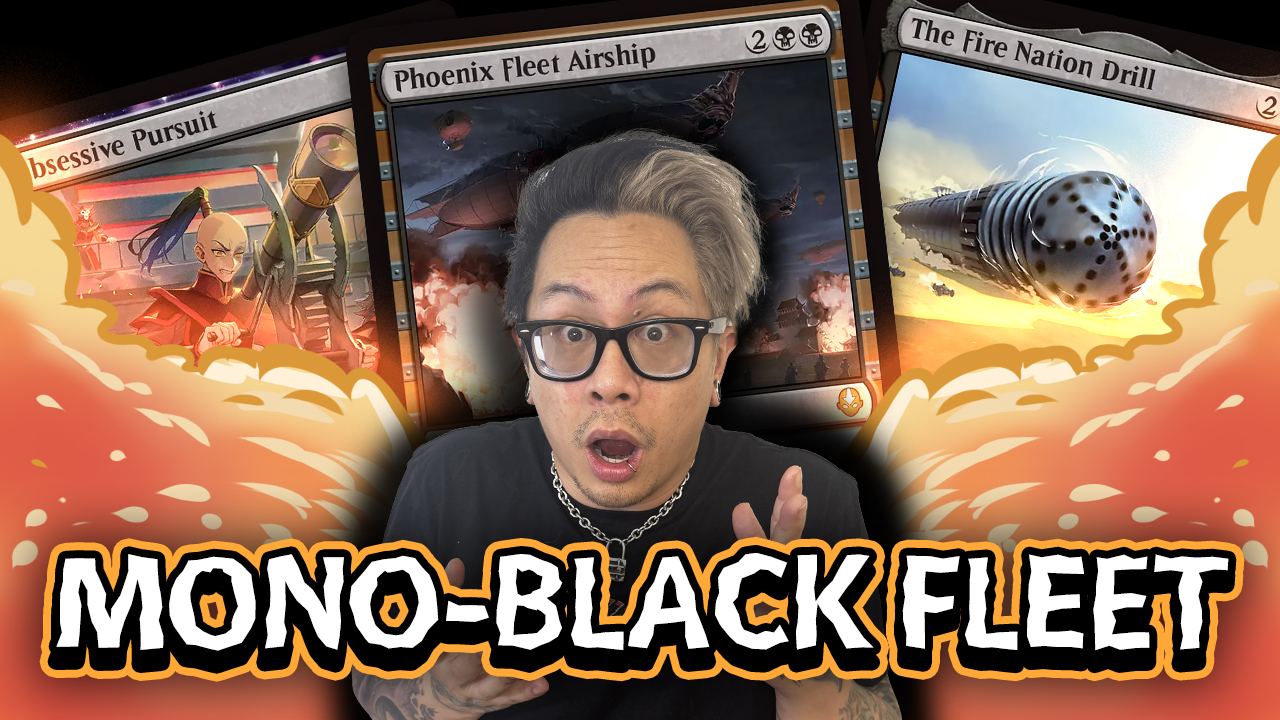The Financial Impact of BFZ: Expeditions Meta-Discusson, Gideon, and Ulamog
A couple days ago we started breaking down the Battle for Zendikar PAX news with a discussion of the various lands that will appear in the set. While Zendikar Expeditions, full art basics and slowlands were likely the most exciting news to come from the event, they were far from the only news. Today we are going to break down the other exciting spoilers to come out over the weekend including Gideon, Ally of Zendikar and Ulamog, the Ceaseless Hunger, but first we need to talk a little bit more about the lands. However, this time instead of focusing on the lands themselves, we need to talk about the impact they will have on the set as a whole and the other cards printed in the set.
Zendikar Expeditions Meta-Discussion



While I wrote about the Expeditions themselves a couple days ago, what I didn't really get an opportunity to discuss is the impact their inclusion in Battle for Zendikar boosters will have on the set as a whole. This is actually extremely important because it sets the stage not only for our discussion of Ulamog, the Ceaseless Hunger and Gideon, Ally of Zendikar, but every other card and article on the topic for the rest of spoiler season.
I estimated in the last article that Expeditions would be priced as follows: $250-$400 (or more) for blue fetches, around $200 for other fetches, ~$100 for shocks and $50 or a bit less for slowlands. This would place the average cost of an expedition somewhere around $150 (since there are more fetches than slowlands). Assuming we get about one of these per case, Expeditions adds about $25 to the expected value of a booster box. When you consider the regular printing of the slowlands is adding another $25 dollars to the box EV, and the full-art basics might add another $10, it becomes clear that the lands in a Battle for Zendikar box are taking up a ton of the set's value.
To put this in perspective, the fetchland cycle added about $45 to the EV of a KTK box, and the basic-land-slot fetches in Fate Reforged accounted for about $17 of a box's expected value. So having expeditions and slowlands eat up around $50 of a box's EV isn't really unprecedented. In fact, it is fairly typical of a set with an eternal playable land cycle. This is extremely important for a few reasons:
Firstly, even though we are three weeks away from our traditional EV article, I can tell you right now that if you can find boxes for $90-$100, it is going to be extremely likely that you will make money (on average) opening them on release day. Of course this is counting Expeditions, which are rare enough that variance can play a huge role, so the more you open the better your chances will be. Based purely on past sets with a similar EV number from the land slot, I expect that you will be able to sell the cards from an opened box of BFZ for somewhere between $125 and $150 when it releases (assuming my Expeditions estimates are correct). So if you are looking for an excuse to crack some packs, this might be your set assuming you are willing to go all the way and open a bunch of product.
Second, if you can buy BFZ sealed product now for at or near MRSP, it seems very likely that you can make a significant profit in three to five years assuming no major catastrophes befall the game and they don't find an excuse to reprint the Expeditions in some odd From the Vault like supplemental product.
Third, while the EV of a box of Battle for Zendikar may begin at $125 or even $150, I promise you that it will end up $75 or under after a few months, just like every other in-print set. Since the ultra-rare Expeditions should have high demand relative to their minuscule supply, it seems unlikely that these will be the cards that lose significant value. What this suggests is that the rest of the cards are going to be extremely inexpensive. We can see this to some extent with Khans of Tarkir, where cards like Sorin, Solemn Visitor and Siege Rhino are under $8 despite being Modern playable, and most Standard staples like Mantis Rider are almost bulk despite seeing significant play in tier one decks. Battle for Zendikar should be the same way, which means Gideon, Ally of Zendikar, a card that could be $40 if printed in Dragon's Maze or Journey into Nyx, is going to struggle to keep its head above water.
What does this mean? It means Expeditions is great for everyone. People who want to spend $1000 on a playset to pimp out their Legacy or EDH decks have a great new options. Cards like this should exist. In the same way that every sets contains cards and themes for various demographics, Wizards can and should pay attention to pimpers and collectors as well. Standard players, on the other hand, benefit not only from having a chance to open a $200 card in their fat pack or booster box, but also because the rest of the set will be priced much lower. The combination of fetches in KTK and Expeditions in BFZ will likely mean that the next six months will be the cheapest Standard in the modern era. Seriously, this combo of lands is basically giving you a 25 percent discount off your Standard deck(s), so even though you (or I) might never own a playset of foil, full art Scalding Tarns, we still benefit.
This is the reason I needed to discuss the meta-impact of the Zendikar Expeditions before talking about other cards. As you are reading this article, and the rest of my articles during spoiler season, keep this in mind. If you think "this guy is crazy, Gideon, Ally of Zendikar is way better than a $10 card," know that you are right. In terms of powerlevel and playability, many of the cards in BFZ will likely be better than their prices indicate. But most of the rares and mythic from Battle for Zendikar will be cursed from birth, just because of the set they're are printed in and the cards around them. But like I said a moment ago, this is a good thing for players. Let the pimpers, Legacy players, and EDH aficionados subsidize your Standard cards by paying obscene amounts for full art fetches and enjoy your ability to pick up some extremely powerful cards at a discounted price.
Gideon, Ally of Zendikar
At level one, Gideon, Ally of Zendikar is a four-mana, indestructible Glorious Anthem with upside. Regardless of the board state or what removal your opponent has in hand, he can always be this (assuming he resolves) because you can immediately ultimate for the Glorious Anthem emblem. Whether or not a four mana Glorious Anthem is good enough is another question. Most recently we've had Spear of Heliod (a three mana Glorious Anthem with upside) and Hall of Triumph (a three-mana, colorless Glorious Anthem with downside), but both were legendary, which probably explains why they were only played as one-ofs when they did show up in decks. On the other hand, four mana feels like a lot for a Glorious Anthem. If your creature buff isn't coming down until turn four, you're already in the land of Siege Rhinos which means your one-drop probably isn't getting through much damage. So while I'm not sure how much play a four-mana indestructible Glorious Anthem would see, the good news about Gideon, Ally of Zendikar is that there is a lot more to the card.
The 0 ability is quite similar Garruk Relentless and Xenagos, the Reveler. While the 2/2 Ally tokens give up the haste from Xenagos' Satyr Tokens, they gain some Ally synergies that may or may not be relevant in Standard. Even if there isn't a competitive Ally deck, it is likely that having this Ally synergy could make Gideon, Ally of Zendikar more popular in casual circles where Allies are among the most popular kitchen table tribes. Thankfully, Allies don't need to matter for the 2/2 token to be good. No one cared that Xenagos, the Reveler made Satyrs or that Garruk Relentless made Wolves; just being able to make infinite chump blockers or attackers is often good enough. Plus being able to make a creature right away crosses off the "can protect itself" mark on the "is this planeswalker playable" list.
Finally, the +1 ability is quite similar to Gideon Jura's creature form. Yes, you are giving up one power and toughness, but you also get the mana cost reduced by one. While we have no idea how the metagame will look post Battle for Zendikar, it is a good bet that Siege Rhino will still be a part of it, so being just big enough to attack through a 4/5 is important. The biggest difference between Gideon Jura and Gideon, Ally of Zendikar is in how they play. Since Gideon Jura starts off on 8 loyalty (if you +2) and can gain two more every turn, most of my experiences with the card have been in control. You slam a Gideon Jura, plus it for a while until you can take control of the game, and eventually use it to finish off the opponent over the course of a few turns. This plan doesn't really work with Gideon, Ally of Zendikar because it not only starts off with less loyalty, but it only gains loyalty at half the rate. This combined with the Glorious Anthem ultimate makes me think this is mostly an aggro card, but it's possible that simply making a 2/2 every turn is enough repeatable, incremental advantage for control decks as well.
Financially, how good or bad, playable or unplayable Gideon, Ally of Zendikar ends up being doesn't really matter all that much. For this card to be worth $15+ six months from now, it is going to have to dominate Standard, as in a four-of in a top three deck. Could this happen? Sure. But a more likely outcome for Gideon, Ally of Zendikar is to end up in the $5-$10 range like Sarkhan, Dragonspeaker, Sorin, Solemn Visitor, Xenagos, the Reveler and basically ever other non-Elspeth, Sun's Champion fall-set planeswalker printed over the past couple years. This low-price tag will likely remain true even if Gideon, Ally of Zendikar sees play. Sorin, Solemn Visitor is under $10 despite seeing play not only in Standard, but in Modern Abzan as well, simply because it happened to be printed in a set containing the second-best non-basic land cycle of all time.
So, in sum, I like Gideon, Ally of Zendikar as a card. It might even go down as the second best Gideon ever printed behind Gideon Jura. But I expect him to have difficulty holding a price above $10 just because of the rest of the cards in the set.
Ulamog, the Ceaseless Hunger
The thing that made the original Eldrazi Titans (Emrakul, the Aeons Torn, Ulamog, the Infinite Gyre, and Kozilek, Butcher of Truth) great is just how depressing it is to see Annihilator on the other side of the table. Sure, maybe you can find some sort of answer, but once you sacrifice half of your permanents, it feels like you've already lost the game. You get this sinking feeling in your stomach as you start sorting your resources into the "sacrifice" pile, your head droops, your shoulders slump — this is what is suppose to happen when you get attacked by an Eldrazi Titan, the biggest, baddest creatures in the entire game of Magic.
Milling 20 does not have this effect.
Let's say Ulamog, the Ceaseless Hunger comes down on turn 10 and you have 43 cards left in your library. Assuming your opponent casts it from hand, they get to exile two permanents (one more than Ulamog, the Infinite Gyre, which is definitely strong). You don't have an answer in hand, so you'll need to take on hit from Ulamog, the Ceaseless Hunger. Ulamog, the Ceaseless Hunger attacks, you exile the top 20 cards of your library, shrug your shoulders, smile a little, cast Dig Through Time, find an answer and go on to win the game.
With the original Eldrazi, giving your opponent one attack step was often devastating, usually enough to cost you the game. With Ulamog, the Ceaseless Hunger, this is definitely not the case. You can almost always take one attack from Ulamog, the Ceaseless Hunger (and in some instances two attacks) and still have a reasonable expectation of winning the game. While the number of cards in your deck only really matters when it hits zero (or gets very close to zero), the number of permanents you have on the battlefield almost always matters. While it may look like the new Ulamog is a two or three turn clock thanks to the mill-esque exiling, the way this "damage" breaks down is odd. Basically, the first attack does 0 damage, the second attack does either 0 or infinite damage (depending on how many cards are in your opponents deck) and the third attack always equals your opponent's life total. Obviously if Ulamog, the Ceaseless Hunger is left unchecked it will win you the game, but I'm honestly not sure it does so any faster or more effectively than Dragonlord Atarka which costs three less mana.
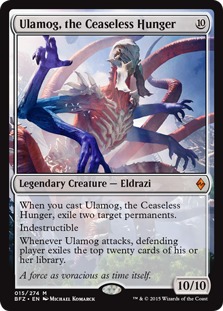
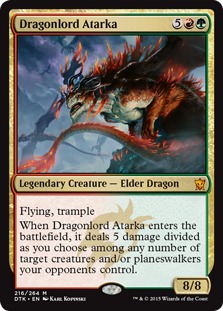
Let's break this down. Both Ulamog, the Ceaseless Hunger and Dragonlord Atarka impact the battlefield immediately when they are cast/enter the battlefield. The benefit of Ulamog, the Ceaseless Hunger is that it triggers when cast (so it is better against counterspells) and that it exiles any two permanents (so against a board of Dragonlord Atarka and Dragonlord Dromoka, Ulamog is insane). On the other hand, Dragonlord Atarka triggers when it enters the battlefield which means you can get value with See the Unwritten and reanimation spells, and against a board of five Thopter Tokens it can clean everything up. I would call the cast/ETB trigger a wash; both cards have advantages and disadvantages based on the situation and much of it will depend on the metagame post-Battle for Zendikar.
Both cards offer an evasive three-turn clock. The difference is Dragonlord Atarka deals real damage, while Ulamog, the Ceaseless Hunger is likely getting chumped by a 1/1 and milling 20. This is a big deal in the "dies after one attack" scenario we were just talking about. Assuming Dragonlord Atarka gets in one hit, she takes away 2/5th of your opponent's starting life total, which opens the door for the rest of your creatures to finish off your opponent. Ulamog, the Ceaseless Hunger is more like playing an Infect deck in Modern, getting your opponent to eight poison counters, and then attacking with Noble Hierarch. All of your Infect damage (or in the case of Ulamog, the Ceaseless Hunger, mill damage) goes for naught. Now, this problem can be minimized by playing an actual mill deck, but then you are playing a mill deck that's attempting to cast a 10-mana creature, which is probably an even bigger problem.
All in all, I believe Dragonlord Atarka is just better than Ulamog, the Ceaseless Hunger in most decks and in most situations. Financially, Ulamog, the Ceaseless Hunger will probably get a bump from casuals and the numerous fans of the Eldrazi tribe. But like Gideon, Ally of Zendikar, Ulamog likely has a ceiling in the $10 range (at least while BFZ is in print) thanks to the Expeditions, full-art basics and very playable slowland cycle eating up so much of the EV. I'd like to predict that over the long term, the combo of being both a mythic Eldrazi and a mill card will mean a massive EDH/casual price tag, but there is a legitimate concern about how much Battle for Zendikar will be opened. I know numerous people who typically would never buy a booster box that are currently searching for booster cases. While expected value is only relevant while a set is in-print, the massive influx of supply is going to be an issue for years and years to come. While I think slow-growth is likely, expecting Ulamog, the Ceaseless Hunger to shoot up to $50 like its Rise of the Eldrazi brethren is optimistic at best and downright foolish at worst.
The Mantis Rider/Siege Rhino Problem

While we haven't seen too many Battle for Zendikar rares so far, there have been a handful spoiled. Some of them seem quite playable, but from a financial perspective, this means very little thanks to the construction of the set. Take a gander at the prices of the rares from Khans of Tarkir and you'll see what I mean. Siege Rhino is currently the second-most played creature in Standard and Modern playable, but it only costs $3.50. Rattleclaw Mystic is the 16th most played creature in Standard and will set you back a whopping $2 per copy. Mantis Rider comes in 18th and is pretty damn close to being a bulk rare.

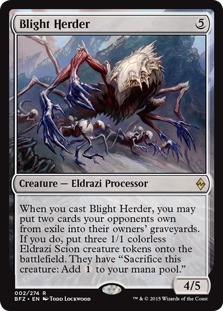
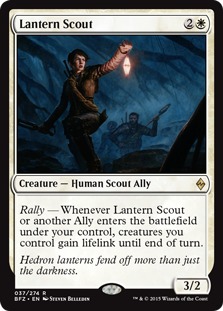
This is the future of Battle for Zendikar. Ruinous Path and Radiant Flames will likely be important cards in Standard providing replacements for the rotating Hero's Downfall and Anger of the Gods. Many of the rare Eldrazi have fairly big bodies for their mana costs; numbers that are efficient enough that they deserve at least some consideration for constructed, depending on how the format shakes out. Hero of Goma Fada and Lantern Scout will likely be staples in the Ally archetype if one exists. But none of these cards will be worth anything.
Ask yourself, "Are any of these cards going to be more playable, more powerful, more in demand than Siege Rhino?" Because this is what it will take for a Battle for Zendikar rare to cost more than $5. The bar for being a $5 rare from BFZ is literally set at "Modern staple and best card in Standard." Now ask yourself, "Is this card going to be a tier one, archetype staple in Standard?" This is what a $1 rare will look like in BFZ.
As such, Ruinous Path and Radiant Flames likely have a ceiling of somewhere between $2 and $3. Even if the Ally deck is top tier in Standard, Hero of Goma Faba and Lantern Scout are going to have difficulty being worth more than $1. Same for the rare Eldrazi. And it is likely that some of the cards on the list will fall even further down the food chain to Butcher of the Horde status as literal bulk rares.
This is awesome for players, at least in the short term. For the next six months, it will be raining Standard staples and assuming you already own your mana base (especially fetches, but also slowlands), you'll be able to play basically any Standard deck you want for the price of one or two copies of Jace, the Mind Sculptor back in ZEN-NPH Standard.
Conclusion
Anyway, that's all for today. As always, leave your thoughts, opinions and criticisms in the comments, and you can reach me on Twitter (or MTGO) @SaffronOlive.



